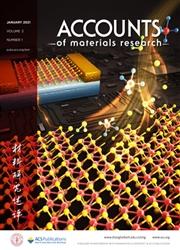Facile Strategies for Incorporating Chiroptical Activity into Organic Optoelectronic Devices
IF 14
Q1 CHEMISTRY, MULTIDISCIPLINARY
引用次数: 0
Abstract
Chiral optoelectronics, which utilize the unique interactions between circularly polarized (CP) light and chiral materials, open up exciting possibilities in advanced technologies. These devices can detect, emit, or manipulate light with specific polarization, enabling applications in secure communication, sensing, and data processing. A key aspect of chiral optoelectronics is the ability to generate or detect optical and electrical signals by controlling or distinguishing CP light based on its polarization direction. This capability is rooted in the selective interaction of CP light with the stereogenic (non-superimposable) molecular geometry of chiral substances, wherein the polarization of CP light aligns with the intrinsic asymmetry of the material. Among the diverse chiral materials explored for this purpose, π-conjugated molecules offer special advantages due to their tunable optoelectronic properties, efficient light–matter interactions, and cost-effective processability. Recent advancements in π-conjugated molecule research have demonstrated their ability to generate strong chiroptical responses, thereby paving the way for compact and multifunctional device designs. Building on these unique advantages, π-conjugated molecules have advanced organic electronics into rapidly evolving technological fields. The combination of chiral π-conjugated molecules with organic electronics is anticipated to simplify the fabrication of chiroptical devices, thereby lowering technical barriers and accelerating progress in chiral optoelectronics.

将热活动纳入有机光电器件的简单策略
手性光电子技术利用圆偏振光(CP)和手性材料之间独特的相互作用,为先进技术开辟了令人兴奋的可能性。这些设备可以检测、发射或操纵具有特定偏振的光,使安全通信、传感和数据处理中的应用成为可能。手性光电子学的一个关键方面是通过控制或区分CP光的偏振方向来产生或检测光学和电信号的能力。这种能力植根于CP光与手性物质的立体(非重叠)分子几何结构的选择性相互作用,其中CP光的偏振与材料的固有不对称性一致。在为此目的探索的各种手性材料中,π共轭分子由于其可调谐的光电特性,高效的光-物质相互作用和成本效益的可加工性而具有特殊的优势。最近π共轭分子研究的进展已经证明了它们能够产生强烈的热效应,从而为紧凑和多功能的设备设计铺平了道路。基于这些独特的优势,π共轭分子将有机电子学推进到快速发展的技术领域。手性π共轭分子与有机电子学的结合有望简化手性器件的制造,从而降低技术壁垒,加速手性光电子学的发展。
本文章由计算机程序翻译,如有差异,请以英文原文为准。
求助全文
约1分钟内获得全文
求助全文

 求助内容:
求助内容: 应助结果提醒方式:
应助结果提醒方式:


